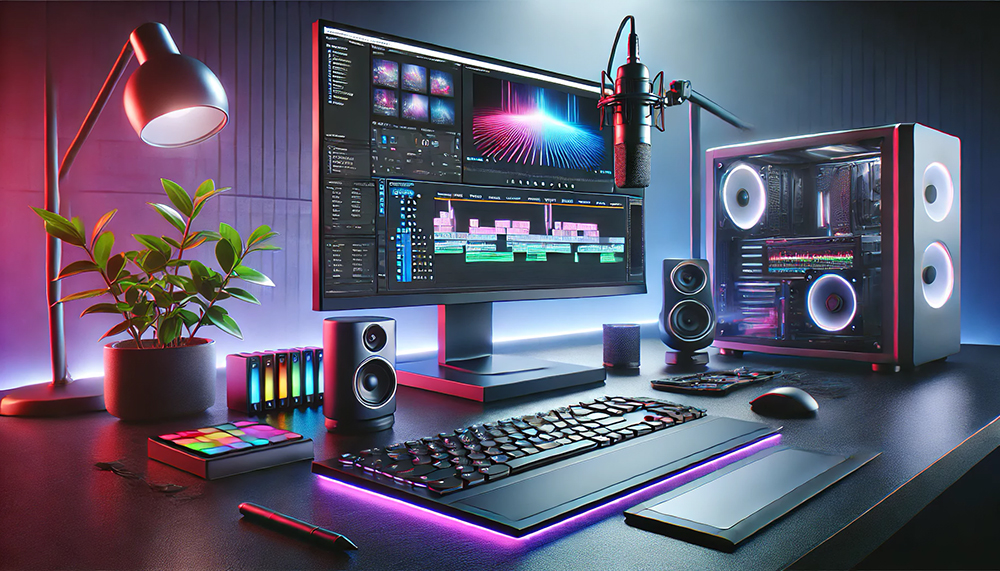Video editing is a demanding task that requires specialized equipment capable of handling intensive workloads. Setting up and maintaining an optimized workstation is essential for smooth and efficient performance. In this article, we explore key components, how to optimize performance, and best maintenance practices to maximize its lifespan.
Discover all our workstations at the following link.
Key Components for Video Editing
Choosing the right components is critical to building a workstation that meets the demands of video editing, especially at 4K and higher resolutions.
Processors: How many cores do you need?
The processor is the brain of your workstation. For video editing:
- 1080p projects: A processor with 6-8 cores, such as the AMD Ryzen 5 5600X or Intel Core i5-13600K, is sufficient.
- 4K or higher projects: Opt for processors with at least 12 cores, such as the AMD Ryzen 9 7900X or Intel Core i9-13900K.
A higher core count makes multitasking easier and reduces rendering times.
GPU: Graphics power for rendering
The GPU is essential for accelerating tasks such as rendering and applying real-time effects. Some recommended options are:
- NVIDIA GeForce RTX 4070: Excellent balance between price and performance.
- AMD Radeon RX 7900 XT: Ideal for intensive workflows with multiple monitors.
If you use software like DaVinci Resolve, which is very GPU-dependent, consider investing in a high-end card.
Storage and RAM: What’s Ideal?
Having enough storage and fast RAM is vital for handling large files and working without interruptions.
SSD vs HDD: Speed vs Capacity
- SSD: Use these for the operating system, software, and ongoing projects. Models like the Samsung 980 Pro offer fast speeds for uploading and editing.
- HDD: Suitable for storing large files and finished projects due to their higher capacity and lower cost per GB.
A hybrid setup, with a 1TB SSD for everyday work and a 4TB or larger HDD for storage, is ideal.
Recommended RAM for 4K projects
- 16GB: Minimum for basic 1080p editing.
- 32GB: Recommended for 4K workflows or intensive multitasking.
- 64GB or more: Ideal for complex projects with multiple layers and visual effects.
How to Optimize Your Workstation’s Performance
A well-configured workstation can make the difference between a smooth experience and a frustrating one.
Software and driver configuration
- Update drivers regularly: Especially GPU drivers to ensure compatibility and performance improvements.
- Configure your editing software: Adjust parameters such as cache memory and rendering preferences according to your hardware specifications.
- Use proxies: To edit 4K projects on less powerful computers without compromising final quality.
Cooling solutions for long sessions
Excessive heat can reduce performance and component lifespan. Consider:
- Air cooling: Solutions like the Noctua NH-D15 are efficient and quiet.
- Liquid cooling: Ideal for intensive workstations. Models like the Corsair iCUE H150i are reliable and effective.
Regular Maintenance to Maximize Lifespan
Proper maintenance not only prolongs the lifespan of your workstation, but also ensures optimal performance.
Internal Cleaning and Upgrading Components
- Regular Cleaning: Blow dust out of fans, heatsinks, and ports with compressed air every 3-6 months.
- Upgrades: Consider replacing components like the GPU or adding more RAM as your needs evolve.
Performance Monitoring with Digital Tools
- Monitoring Software: Tools like HWMonitor or NZXT CAM help you track temperatures and performance in real time.
- Stress Testing: Run tests with programs like Cinebench or 3DMark to make sure your rig is performing at its best.
Building and Maintaining a Video Editing Workstation It’s an investment in time and resources that pays off. With the right components, an optimized setup, and consistent maintenance, you can ensure smooth and efficient performance for any project, from basic videos to film productions. Let your creativity flow without limits!







